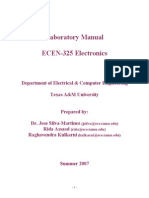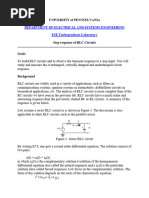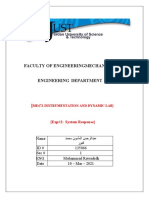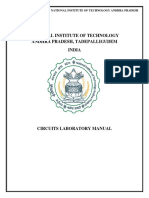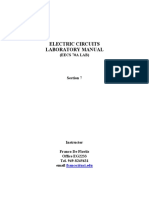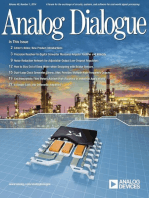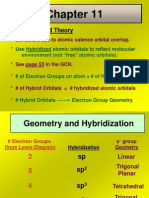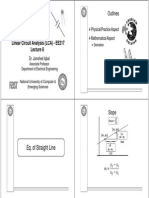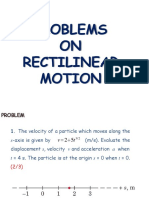Lab 7 Dynamic Parameters of 2 Order Measurement Systems
Uploaded by
raylo4594Lab 7 Dynamic Parameters of 2 Order Measurement Systems
Uploaded by
raylo4594Lab 7
Dynamic Parameters of 2nd Order
Measurement Systems
Prepared For:
Bradley Thorne
ME 337L, Section 1002
Department of Mechanical Engineering
University of Nevada, Las Vegas
Prepared By:
Raymond Lopez, Mail Box #24
Group Member:
Dominic Picardal
Date Performed:
March 20, 2015
Due Date:
March 27, 2015
Abstract
Introduction
This lab used the NI ELVIS function generator, oscilloscope, and Bode
analyzer to examine a replication of a 2nd order system constructed from an
RLC circuit on the ELVIS protoboard. 2nd order systems can show two types of
responses: a transient response, where the system responds to a change or
disturbance acted upon it, and a steady-state response, where the system
remains unchanged for a period of time. This lab used a step input square
wave from the function generator to replicate a transient response on the
system, and a continuous sine wave to generate a steady-state response
from the system.
Because the system is of type 2nd order, equations dealing with the
system were 2nd order differential equations. Terms such as natural
frequency (n) and damping ratio () were introduced. Natural frequency of
a system refers to the frequency the system would naturally oscillate at if
there was no applied force on it. The damping ratio measures the rate at
which the oscillations resulted from a disturbance on the system dwindle
over time. When these terms are introduced into a 2nd order differential
equation relating the components of the circuit, the equation is
1 d 2Vc (t ) 2 dVc (t )
Vc (t ) V (t )
n2 dt 2
n dt
Here, the natural frequency and damping ratio can be calculated as
1
1
, R C/L
2
LC
The values calculated can then be substituted into the theoretical transient
response equation shown below (K = gain, A = amplitude of input signal):
w n t
y (t )=KAKA e
sin ( wn t 1 2) +cos ( w n t 1 2 ) 0 <1
2
1
For a steady-state response, two values (amplitude ratio, M() and
phase shift, ()) are needed. The amplitude ratio is a measure of the
output voltage to the input voltage from the signal. The amplitude ratio can
also be calculated theoretically using the following formula:
M ( )=
{[
1 /2
( )] [ ]}
1
n
2 2
2
+
n
The phase shift is also known as the phase difference between the output
and input signals and can be calculated as:
2
n
1
n
( ( ))
( )=tan1
Procedure
Before the RLC circuit was constructed, the 100 resistor, 0.1 F
capacitor, and 68 mH inductor needed to be measured using the DMM to
obtain their actual values to be used in the calculations later on. Then the
RLC circuit shown in Figure 1 was constructed. The function generator and
oscilloscope were needed for the first part of the lab. Once everything was
connected and the power switched on, the function generator was set to a
square waveform type (to replicate a transient response), the frequency to
100 Hz, and peak amplitude to 1. The controls on the oscilloscope were
adjusted to accept the signal input from the ELVIS workstation. The rise time
of the signal was found first by placing cursor C1 at the base of the step
input. Rise time was calculated at 90% of the value shown for Vp-p of the
input, and cursor C2 was placed at this value. The experimental rise time
was shown as dT on the oscilloscope.
For settling time, C1 was again placed at the base of the step input.
C2 was placed within the range of 10% of Vp-p of the input. dT on the
oscilloscope was the experimental settling time. The period of oscillation
was determined by changing the input signal channel to the same channel as
the output. C1 was placed at the first output peak and C2 was placed at the
second output peak. dT displayed the experimental period of oscillation.
Figure 1: RLC circuit used for the lab
To obtain a steady-state response from the signal, the function
generator was adjusted to input a sine wave to the signal rather than a
square wave step input. The function generator was then further adjusted
for different input frequencies, ranging from 100 to 3000 Hz. The cursors at
each frequency were both placed at peaks on the input and output signal.
The experimental amplitude ratio could then be calculated as
V
V
( pp)input
. Experimental phase shift was calculated as:
( p p) output /
deg =dTfrequency input ( Hz )2
180
Then, the function generator and oscilloscope were closed so that the Bode
analyzer could be used. The start frequency was set to 100 Hz, stop
frequency to 3000 Hz, peak amplitude of 1, and 20 steps per decade. The
Bode analyzer can be seen in Figure ************
Results/Discussion
The first objective of the lab was to measure the true value for each
component of the RLC circuit. These values can be seen in Figures 2, 3, and
4.
Figure 2: Resistor value
Figure 4: Inductor value
Figure 3: Capacitor value
The theoretical value for the natural frequency (n) was:
n=
1
1
rad
=
=11777.7
3
7
s
LC ( 68.01 10 )(1.060 10 )
The theoretical value for the damping ratio () was:
1
1
1.060 107
= R C /L= ( 0.09713 103 )
=0.06063
3
2
2
68.01 10
The experimental rise time, shown as dT in Figure 5 was 158 s. The
experimental settling time, shown in Figure 6 as dT was 674 s.
Figure 5: Scope of signal (dT = rise time)
of signal (dT = settling time)
Frequency,
Hz
Frequency,
Rad/s
Amplitudes Ratio (Volt/Volt)
(Gain)
Figure 6: Scope
Phase Shift
Theoretical
Theoretical
Amp.
Phase
/ n
Vc
Vc
Time(sec)
Degrees
Ratio
Shift
(Degrees)
100
200
0.05334
1.015
1.019
0.996075
-0.00001
-0.36
1.00283
-0.371642
500
1000
0.2667
1.078
1.018
1.05894
-0.000018
-3.24
1.07592
-1.99403
900
1800
0.4801
1.251
1.007
1.2423
-0.000056
-18.144
1.29584
-4.32648
1200
2400
0.6402
1.503
0.9873
1.52233
-0.00005
-21.6
1.68003
-7.49396
1500
3000
0.8002
1.874
0.94581
1.98137
-0.00007
-37.8
2.68429
-15.0975
1700
3400
0.9069
2.083
0.90496
2.30176
-0.00011
-67.32
4.78851
-31.7757
1800
3600
0.9603
2.070
0.89101
2.32321
-0.000126
-81.648
7.1399
-56.2442
1900
3800
1.0136
1.978
0.88647
2.23132
-0.000136
-93.024
7.94136
77.4393
2000
4000
1.0670
1.836
0.89413
2.05339
-0.000146
-105.12
5.27636
43.0534
2100
4200
1.1203
1.642
0.90828
1.80781
-0.000154
-116.424
3.4603
28.0391
2300
4600
1.2270
1.283
0.93869
1.3668
-0.000158
-130.824
16.4001
2600
5200
1.3871
0.89603
0.97113
0.922667
-0.000154
-144.144
10.3163
3000
6000
1.6004
0.59556
0.98666
0.603612
-0.000142
-153.36
7.08543
0.06063
You might also like
- National 5 Physics Practice Workbook AnswersNo ratings yetNational 5 Physics Practice Workbook Answers26 pages
- (Ground Vehicle Engineering) Donald E. Struble Ph.D.-automotive Accident Reconstruction - Practices and Principles-CRC Press (2013)100% (3)(Ground Vehicle Engineering) Donald E. Struble Ph.D.-automotive Accident Reconstruction - Practices and Principles-CRC Press (2013)466 pages
- Eleg. 2111 Laboratory 6 "Q" Factor and Transient Response of An RLC Series CircuitNo ratings yetEleg. 2111 Laboratory 6 "Q" Factor and Transient Response of An RLC Series Circuit9 pages
- ESC201 Lab 3_Lab Handout for Experiments_1abb3429-0e6d-430a-841d-67e91fe690d6No ratings yetESC201 Lab 3_Lab Handout for Experiments_1abb3429-0e6d-430a-841d-67e91fe690d64 pages
- Experiment # 1: Time and Frequency Responses of Series RLC CircuitsNo ratings yetExperiment # 1: Time and Frequency Responses of Series RLC Circuits6 pages
- To Analyze The Sinusoidal Response of RLC CircuitNo ratings yetTo Analyze The Sinusoidal Response of RLC Circuit4 pages
- Comsats University Islamabad, Islamabad Campus: Lab Report # 12No ratings yetComsats University Islamabad, Islamabad Campus: Lab Report # 123 pages
- Experiment 4: Damped Oscillations and Resonance in RLC CircuitsNo ratings yetExperiment 4: Damped Oscillations and Resonance in RLC Circuits6 pages
- LRC Circuits Resonances - George Ricarrson 2501987261100% (1)LRC Circuits Resonances - George Ricarrson 250198726114 pages
- L #1: T F R S C: Sfsu - E 301 - E L AB Ime and Requency Esponses of Eries IrcuitsNo ratings yetL #1: T F R S C: Sfsu - E 301 - E L AB Ime and Requency Esponses of Eries Ircuits8 pages
- RC and RLC Circuits.: Experiment 4. EECE 310LNo ratings yetRC and RLC Circuits.: Experiment 4. EECE 310L22 pages
- Experiment 6 Sinusoidal Steady State: ObjectiveNo ratings yetExperiment 6 Sinusoidal Steady State: Objective5 pages
- LRC Circuits Resonance - Muhammad Raihan Sunaryo - 2602130211No ratings yetLRC Circuits Resonance - Muhammad Raihan Sunaryo - 260213021112 pages
- EE302 Lab 9 - Common Source Amplifier - v2-1No ratings yetEE302 Lab 9 - Common Source Amplifier - v2-19 pages
- Lab #2 Ac Measurements: EE 200 - Electronic Circuits ImplementationNo ratings yetLab #2 Ac Measurements: EE 200 - Electronic Circuits Implementation8 pages
- Fundamentals of Electronics 3: Discrete-time Signals and Systems, and Quantized Level SystemsFrom EverandFundamentals of Electronics 3: Discrete-time Signals and Systems, and Quantized Level SystemsNo ratings yet
- Electric Circuits Laboratory Manual: (Eecs 70A Lab)No ratings yetElectric Circuits Laboratory Manual: (Eecs 70A Lab)6 pages
- (Physics of Solids and Liquids) N. H. March (Auth.), S. Lundqvist, N. H. March (Eds.) - Theory of The Inhomogeneous Electron Gas-Springer US (1983)No ratings yet(Physics of Solids and Liquids) N. H. March (Auth.), S. Lundqvist, N. H. March (Eds.) - Theory of The Inhomogeneous Electron Gas-Springer US (1983)405 pages
- Sound Absorber: Absorption, Attenuation and Reflection100% (1)Sound Absorber: Absorption, Attenuation and Reflection12 pages
- Linear Circuit Analysis (LCA) - EE217: Eq. of Straight Line Eq. of Straight LineNo ratings yetLinear Circuit Analysis (LCA) - EE217: Eq. of Straight Line Eq. of Straight Line8 pages
- G17 - Dynamics - Rectilinear Motion - ProblemsNo ratings yetG17 - Dynamics - Rectilinear Motion - Problems27 pages
- Important Topics Derivation and QuestionNo ratings yetImportant Topics Derivation and Question5 pages
- Boiler Turbine Dynamics in Power Plant ControlNo ratings yetBoiler Turbine Dynamics in Power Plant Control12 pages
- Scanning Electron Microscopy (SEM) : D.S. SuNo ratings yetScanning Electron Microscopy (SEM) : D.S. Su46 pages
- The Ultimate Guide To C1000-107 IBM Netcool Operations Insight v1.6.1 AdministrationNo ratings yetThe Ultimate Guide To C1000-107 IBM Netcool Operations Insight v1.6.1 Administration2 pages
- Study of Mechanical Vibrations in Dynamics of MachineryNo ratings yetStudy of Mechanical Vibrations in Dynamics of Machinery22 pages
- Student Exploration: Free-Fall LaboratoryNo ratings yetStudent Exploration: Free-Fall Laboratory2 pages
- Drag Force On A Cylinder Exerted by The Creeping Flow of A Generalized Newtonian Fluid"No ratings yetDrag Force On A Cylinder Exerted by The Creeping Flow of A Generalized Newtonian Fluid"6 pages
- (Ground Vehicle Engineering) Donald E. Struble Ph.D.-automotive Accident Reconstruction - Practices and Principles-CRC Press (2013)(Ground Vehicle Engineering) Donald E. Struble Ph.D.-automotive Accident Reconstruction - Practices and Principles-CRC Press (2013)
- Eleg. 2111 Laboratory 6 "Q" Factor and Transient Response of An RLC Series CircuitEleg. 2111 Laboratory 6 "Q" Factor and Transient Response of An RLC Series Circuit
- ESC201 Lab 3_Lab Handout for Experiments_1abb3429-0e6d-430a-841d-67e91fe690d6ESC201 Lab 3_Lab Handout for Experiments_1abb3429-0e6d-430a-841d-67e91fe690d6
- Experiment # 1: Time and Frequency Responses of Series RLC CircuitsExperiment # 1: Time and Frequency Responses of Series RLC Circuits
- Comsats University Islamabad, Islamabad Campus: Lab Report # 12Comsats University Islamabad, Islamabad Campus: Lab Report # 12
- Experiment 4: Damped Oscillations and Resonance in RLC CircuitsExperiment 4: Damped Oscillations and Resonance in RLC Circuits
- LRC Circuits Resonances - George Ricarrson 2501987261LRC Circuits Resonances - George Ricarrson 2501987261
- L #1: T F R S C: Sfsu - E 301 - E L AB Ime and Requency Esponses of Eries IrcuitsL #1: T F R S C: Sfsu - E 301 - E L AB Ime and Requency Esponses of Eries Ircuits
- LRC Circuits Resonance - Muhammad Raihan Sunaryo - 2602130211LRC Circuits Resonance - Muhammad Raihan Sunaryo - 2602130211
- Lab #2 Ac Measurements: EE 200 - Electronic Circuits ImplementationLab #2 Ac Measurements: EE 200 - Electronic Circuits Implementation
- Fundamentals of Electronics 3: Discrete-time Signals and Systems, and Quantized Level SystemsFrom EverandFundamentals of Electronics 3: Discrete-time Signals and Systems, and Quantized Level Systems
- Electric Circuits Laboratory Manual: (Eecs 70A Lab)Electric Circuits Laboratory Manual: (Eecs 70A Lab)
- Analog Dialogue, Volume 48, Number 1: Analog Dialogue, #13From EverandAnalog Dialogue, Volume 48, Number 1: Analog Dialogue, #13
- (Physics of Solids and Liquids) N. H. March (Auth.), S. Lundqvist, N. H. March (Eds.) - Theory of The Inhomogeneous Electron Gas-Springer US (1983)(Physics of Solids and Liquids) N. H. March (Auth.), S. Lundqvist, N. H. March (Eds.) - Theory of The Inhomogeneous Electron Gas-Springer US (1983)
- Sound Absorber: Absorption, Attenuation and ReflectionSound Absorber: Absorption, Attenuation and Reflection
- Linear Circuit Analysis (LCA) - EE217: Eq. of Straight Line Eq. of Straight LineLinear Circuit Analysis (LCA) - EE217: Eq. of Straight Line Eq. of Straight Line
- The Ultimate Guide To C1000-107 IBM Netcool Operations Insight v1.6.1 AdministrationThe Ultimate Guide To C1000-107 IBM Netcool Operations Insight v1.6.1 Administration
- Study of Mechanical Vibrations in Dynamics of MachineryStudy of Mechanical Vibrations in Dynamics of Machinery
- Drag Force On A Cylinder Exerted by The Creeping Flow of A Generalized Newtonian Fluid"Drag Force On A Cylinder Exerted by The Creeping Flow of A Generalized Newtonian Fluid"













